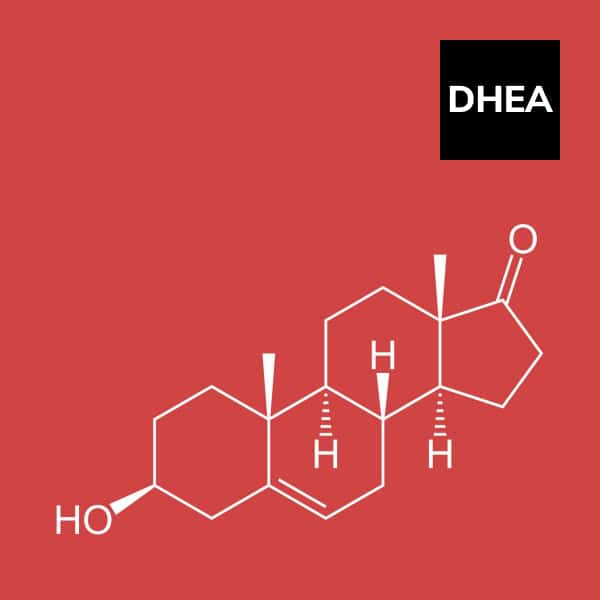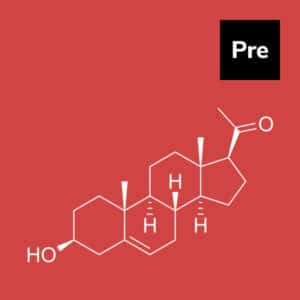Overview
Dehydroepiandrosterone (pronounced dee-hi-dro-ep-i-an-dro-stair-own), often known as DHEA, is the most prevalent steroid in human circulation. It is also one of the most dependable biomarkers of aging. DHEA is released by the adrenal glands and generated in the gonads (testes and ovaries) and brain. It is referred to as the “mother of all hormones” since it serves as the foundation for the production of estrogen and testosterone. It is essential to one’s health and well-being.
Key Benefits:
- Acts as a hormone regulator
- Improves the outcome of in vitro fertilization in women
- Promotes healthy high-density lipid (HDL) levels
- Stimulates the production of human growth hormone (HGH)
- Boosts immunity by stimulating killer-T cell activity
- Improves mood by increasing serotonin
- Supports cognitive function
- Promotes libido and sexual function.
History of Usage
Adolf Frederick Johann Butenandt and Leopold Ruzicka were awarded the Nobel Prize in Chemistry in 1939 for their work on the molecular weight and chemical structure of DHEA’s primary oxidative metabolites.
Butenandt’s contacts with the German pharmaceutical company Schering resulted in the manufacturing of gram amounts of these steroids and other chemically modified substances of this class.
Schering AG explored these novel biological sterols as pharmacological treatments for endocrine-related illnesses, and the European medical community examined these chemicals in women for problems such as postmenopausal depression, and in men for boosting muscle mass.
Since it was discovered that circulating DHEA-S levels decrease with age, animal pathology experiments were conducted to determine how DHEA may protect against cancer, diabetes, aging, obesity, immune function, bone density, depression, adrenal insufficiency, inflammatory bowel disease, diminished sexual function/libido, AIDS/HIV, chronic obstructive pulmonary disease, coronavirus infection, and coronavirus infection. While the processes by which DHEA improves various diseases in animal models are unknown, much less is known about its function in human disease. We do know that DHEA is a precursor to other sterols like testosterone and estradiol.
The majority of human research contains only modest associations between DHEA levels in the blood and illness outcomes. Some evidence supports DHEA as a therapeutic chemical for postmenopausal women, in-vitro fertilization, numerous autoimmune diseases, and unfavorable health consequences such as acne, embryo virilization during pregnancy, and potential endocrine-dependent malignancies.
The replacement of low levels of DHEA by frequent supplementation has been advocated as a strategy to indirectly slow down the aging process and enhance the quality of life.
Biochemistry
Although the specific process of how DHEA works is unknown, we do know that it serves as a precursor to male and female sex hormones. DHEA production peaks in your mid-20s and subsequently diminishes with age.
DHEA, a bulk androgen in blood circulation, and its sulfated metabolite, DHEA-S, become active when they come into touch with a specific cell or tissue that requires it. The sulfate (the S in DHEA-S) is removed and transformed into active androgenic and estrogenic chemicals required for growth and development.
Recent Trends
Dehydroepiandrosterone, or DHEA, has long been used as a menopausal supplement, as well as for women suffering from osteoporosis and menopause. It has both a prostatic and estrogenic action. Because of its accessibility and low cost, this substance has become a popular herbal, alternative medication. DHEA products are being marketed under a variety of brand names, including DHEA Elite, DHEA Rush, Eureka, GenF20, and GNC Menopause. DHEA is not a new substance; nevertheless, its use has declined in recent years due to safety concerns.
Precautions
DHEA is NOT advised for persons under the age of 30, pregnant or nursing women, or people at risk of breast, uterine, or prostate cancer unless indicated by blood tests. DHEA should also not be taken by persons who have a renal illness, are on dialysis, or have hypoglycemia.
References
- Carolyn M Klinge, Barbara J Clark, Russell A Prough. Dehydroepiandrosterone Research: Past, Current, and Future. Vitam Horm 2018;108:1-28. doi: 10.1016/bs.vh.2018.02.002. Epub 2018 Mar 16.
- Xu L, Hu C, Liu Q, Li Y. The Effect of Dehydroepiandrosterone (DHEA) Supplementation on IVF or ICSI: A Meta-Analysis of Randomized Controlled Trials. Geburtshilfe Frauenheilkd. 2019 Jul;79(7):705-712. doi: 10.1055/a-0882-3791. Epub 2019 Jul 10. PMID: 31303658; PMCID: PMC6620181.
- Kushnir VA, Darmon SK, Barad DH, Weghofer A, Gleicher N. Effects of dehydroepiandrosterone (DHEA) supplementation on sexual function in premenopausal infertile women. Endocrine. 2019 Mar;63(3):632-638. doi: 10.1007/s12020-018-1781-3. Epub 2018 Oct 11. PMID: 30311171.
- Qin Y, O Santos H, Khani V, Tan SC, Zhi Y. Effects of dehydroepiandrosterone (DHEA) supplementation on the lipid profile: A systematic review and dose-response meta-analysis of randomized controlled trials. Nutr Metab Cardiovasc Dis. 2020 Aug 28;30(9):1465-1475. doi: 10.1016/j.numecd.2020.05.015. Epub 2020 Jun 3. PMID: 32675010.
- Xie M, Zhong Y, Xue Q, Wu M, Deng X, O Santos H, Tan SC, Kord-Varkaneh H, Jiao P. Impact of dehydroepianrosterone (DHEA) supplementation on serum levels of insulin-like growth factor 1 (IGF-1): A dose-response meta-analysis of randomized controlled trials. Exp Gerontol. 2020 Jul 15;136:110949. doi: 10.1016/j.exger.2020.110949. Epub 2020 Apr 15. PMID: 32304719.
- Sripada RK, Marx CE, King AP, et al. DHEA enhances emotion regulation neurocircuits and modulates memory for emotional stimuli. Neuropsychopharmacology. 2013;38(9):1798-1807. doi:10.1038/npp.2013.79
- 1. Casson, P. et al (1993) “Oral dehydroepiandrosterone in physiologic doses modulates immune function in postmenopausal women” Am J Obstet Gynecol 169: 1536-39.
- 2. Jakubowicz, D. et al (1995) “Effect of dehydroepiandrosterone on cyclic-guanosine monophosphate in age-advanced men” Ann NY Acad Sci 774: 312-15.




